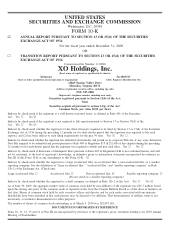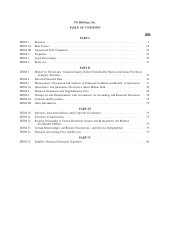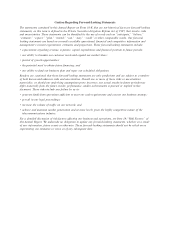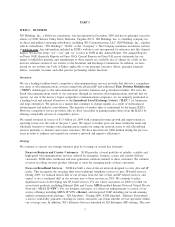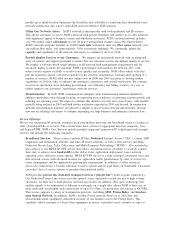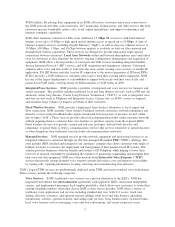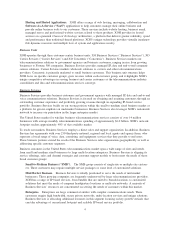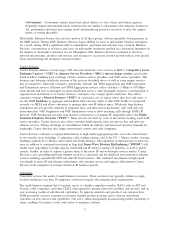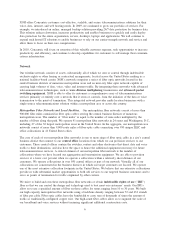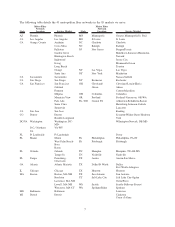XO Communications 2009 Annual Report Download - page 12
Download and view the complete annual report
Please find page 12 of the 2009 XO Communications annual report below. You can navigate through the pages in the report by either clicking on the pages listed below, or by using the keyword search tool below to find specific information within the annual report.Our metropolitan fiber networks are connected by our own switching, routing and optical equipment. The
metropolitan networks are connected to wavelengths of transmission capacity on our inter-city fiber optic
network. By using our own switching and routing equipment, we maximize the capacity and enhance the
performance of our inter-city network as needed to meet our customers’ current and future telecommunications
needs.
Inter-city Network. We have designed and built an advanced and reliable inter-city fiber optic transmission
network using XOH fiber and long-haul dense wave division multiplexing transmission equipment. There are
at least two physically diverse fiber paths connecting most of our markets to their adjacent markets. This
allows us to reroute traffic around inter-city fiber cuts to ensure end-to-end connectivity to our customers.
Metropolitan fiber rings are diversely routed to the XOH POP. This ensures that we can reroute customer
traffic around network impairments.
Our inter-city fiber network primarily comprises a twenty-year IRU for 18 fiber optic strands pursuant to
arrangements with Level 3 Communications, Inc. (“Level 3”). This fiber network traverses over 16,000 miles
and connects more than 60 cities in the United States and Canada, including most of the major metropolitan
markets served by our metropolitan fiber networks. In addition, we have inter-city fiber IRUs from Abovenet
Communications, Inc. (“Abovenet”) and Qwest Communications Corporation (“QCC”) for routes totaling
another 3,000 route miles, including a recently lit QCC dark fiber IRU for a Salt Lake City to Sacramento
route.
We have lit 2 of our 18 fiber optic strands with 400G-capable transmission equipment and have lit an
additional 2 fiber optic strands on segments of our network that required additional capacity with the 800G
technology. During the fourth quarter of 2008, we began to deploy 1.6 Tbps capable systems on select inter-
city routes, and we continued to deploy 1.6 Tbps capable systems on additional inter-city routes in 2009. We
believe that lighting our inter-city fiber network is strategically beneficial to us. Using our own inter-city fiber
optic network and associated transmission and switching equipment provides a lower cost basis for running
our network and a higher level of service for our customers.
IP Network. Our IP network consists of a 10 Gbps ethernet-based high-capacity backbone that runs along
the same routes as our inter-city fiber optic and transmission network. This Nx10G IP/MPLS backbone
connects to ten IP core nodes in the US, three IP core nodes in Europe and one IP core node in Hong Kong,
as well as 70 IP POPs located in 38 US markets and provides connectivity to one XOH-operated hosting data
center. The European and Asian core nodes connect to XO’s North American backbone via 3
rd
party leased
facilities. These IP backbone nodes and POPs provide inter-city IP transport between the XOH metropolitan
fiber networks and the connectivity to other ISPs which is commonly referred to as peering. Peering with
other ISPs is done in each of our fourteen IP core nodes. The IP POPs house customer termination and
aggregating routers, as well as VoIP media gateways for XOH’s softswitch platform.
Our IP/MPLS network architecture, constructed with our own 10 Gbps wavelengths, provides the highest level
of restoration available to IP networks today. Redundant routes and capacity are identified and reserved so that
in the event of a failure, the network will automatically restore traffic in the shortest time possible without the
need for manual intervention. In 2008, we deployed additional high-speed Provider Edge (PE) routers in our
backbone nodes and IP POPs to provide a scalable platform for 1 Gigabit Ethernet (GE) and 10GE ports for
high-speed transit customers, as well as added additional 10GE-capable peering routers to support substantially
greater traffic exchange with other internet backbones. In 2009, we began a program to upgrade the pairs of
PE routers in our metro IP POPs that aggregate traffic from smaller customer-aggregating routers, as well as
provide cost-effective customer terminations at 1GE and 10GE. The modern ethernet-based PE routers have
the potential to support 40Gbps and 100Gbps trunks and customer terminations in the future.
Wireless Network. We hold 91 licenses in the LMDS wireless spectrum (28-31 GHz range) and ten 39 GHz
licenses. These licenses cover 75 basic trading areas (“BTA”), which are typically cities or metropolitan areas
located throughout the United States. For every license, the license holder must make both a license renewal
filing and a demonstration of “substantial service” at the Federal Communications Commission (“FCC”). Our
licenses are renewable for additional ten year terms. The renewal dates for 90 of our LMDS licenses are in
2018, one LMDS license has a renewal date in 2016 and our 39 GHz licenses will be up for renewal in 2010.
8


